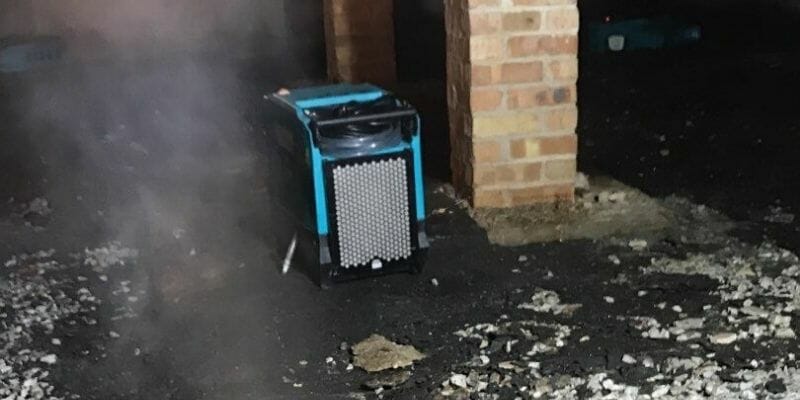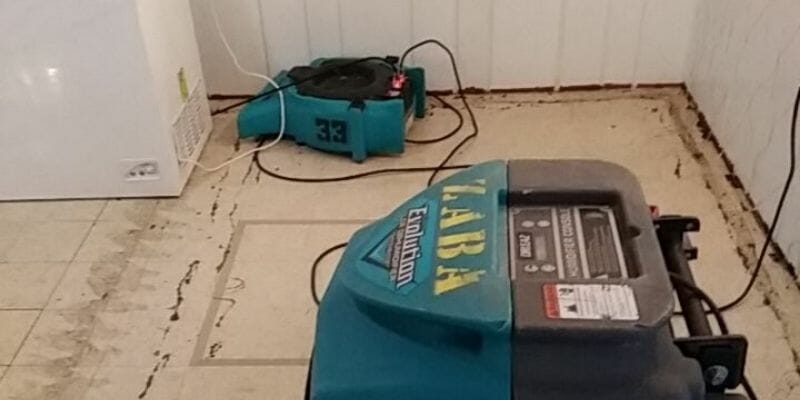Water in the basement always means trouble. Whether it’s dripping from an appliance or seeping through the walls, you need to take care of it right away. Even as you’re sizing up the mess, water is soaking into everything.
You need to fix the problem, remove the water and clean up the downstairs. For years, we’ve helped homeowners with flooded basements in Chicago and the suburbs. This guide to basement water damage is designed to help you.
What Are the Signs of Water Damage in the Basement?

When you see several inches of water on the floor, you know something’s wrong. Some clues can be easier to miss. These are common signs of basement water damage in homes and commercial buildings.
- Single or networked cracks in walls and floors
- Flakes of cement spalling from surfaces
- Efflorescence deposits accumulating on walls
- Crumbled or rotted wood, drywall and plaster
- Yellow- or brown-tinted discoloration on surfaces
- Water coming into the basement where walls meet floors
- Pervasive, unpleasant smells especially around drains
- Mold growth and stains on porous materials and furnishings
Many of these tip-offs aren’t obvious right away. You might not notice hairline cracks in dark corners or efflorescence behind appliances.
Make downstairs inspections a monthly routine. This strategy helps you stay ahead of basement moisture problems before they get worse.
What Causes Basement Water Damage?

You’ve figured out the signs of water damage in your basement. Now, you need to identify the source of the problem. It might take a little handyperson detective work, but you’ll probably find the cause for basement water on this list. We’ve included a quick fix for each one.
• Faulty Sump Pump – Check mechanism, and clear drain.
• Leaky Appliance Hoses – Wrap leaky hoses with plumber’s tape.
• Cracked Basement Walls – Patch or seal with hydraulic cement.
• Leaks Around Windows – Reseal with silicone latex-based caulk.
• Broken Basement Pipes – Turn off water supply, and repair pipes.
• Bad Exterior Drainage – Grade yard to drain away from foundation.

• Sewage Backup – Follow these 10 steps and then call a certified sewage backup cleanup contractor immediately.
• Basement Wall-Floor Leaks – Talk to a foundation specialist about repairs.
How Do You Remove Water From the Basement?
Start by fixing the leak, repairing the break or sealing the crack. You’re ready to start removing water from the basement. If you’re dealing with natural flooding, wait until the event is over before pumping out the water.
Make sure the water level won’t interfere with safely operating pumping and drying equipment. If you’re not sure, turn off breakers to the basement. If you’re looking at more than a few inches of water downstairs, don’t take any chances. Leave the work to water damage professionals.
A submersible pump is your best choice for efficiently removing standing water from the basement. Take care of residual water with a wet vac. You can rent the equipment at many home improvement centers.
How Do You Fix Basement Water Damage?
Fixing a water-damaged basement can be a big job. Most homeowners call in a water damage contractor. Others put their handyperson talents to work on basement water damage with these eight steps.

1. Double-Check Your Safety
If you don’t turn off the basement’s electricity, stay safe by unplugging all downstairs appliances and shutting off any pilot lights. Wear slip-resistant rubber boots while you work.
2. Ventilate the Basement
As long as the weather cooperates, open up any basement windows and doors. Circulating fresh air speeds up the drying process. If it’s humid outside, skip this step.
3. Document the Damage
In order to file a basement water damage claim, you need to document affected areas, materials and belongings. Take pictures before cleaning up so that you can detail the damages for your insurance company.
4. Start the Drying Process
Large air movers and heavy-duty dehumidifiers are essential to efficiently drying out a wet basement. Set up rented equipment so that fans create constant cross-currents throughout the basement. Be sure to regularly check and empty dehumidifier water wells.
6. Tear Out and Dispose
Finished basements need extra work. Start by pulling up ruined carpet and padding. Remove buckled baseboards, pull down stained paneling, and tear out crumbled drywall. Bag and dispose of everything as quickly as possible. Wet materials left in the basement slow down the drying process.
7. Clean and Disinfect

Clean all non-porous surfaces with a strong detergent and water mix. Baking soda and white vinegar make a good deodorizing solution. Follow up by thoroughly disinfecting the basement with bleach and water.
8. Replace and Rebuild
Let the basement dry for several more days. Finish the job by replacing water-damaged carpets. Rebuild torn-out drywall, and replace warped baseboards and paneling. Make sure salvaged furnishings and belongings are completely dry before bringing them back down into the basement.
Who Do You Call for Basement Water Damage Repair?

Basement water cleanup is time-consuming. You have to rent heavy equipment. Cleaning a water-damaged basement can be hard on your health too. Natural flooding and sewage backups expose you to dangerous Category 3 black water. Many homeowners call in water damage restoration pros. It’s a smart choice for several reasons.
• Restoration teams are trained to quickly identify and address the source of water in your basement.
• They work with heavy-duty equipment that speeds up water removal and basement dry-out.
• They’re industry-certified to take care of hazardous Category 3 black water cleanup.
• Technicians handle all tear-out, replacement and reconstruction work.
• Secondary problems like mold, staining and odors are all solved.
• The company’s staff can help you file your homeowners claim for water damage.
An experienced water restoration contractor like ServiceMaster Restoration by Zaba stays on call 24/7. You can have certified technicians on the scene immediately. Their time-efficient process minimizes water damage in the basement regardless of its source. Your basement is quickly restored to it’s pre-water damage condition.
What Is the Average Cost of Basement Water Damage?
The cost of basement water damage depends on several factors. Basement size, the extent of damages and cleanup difficulty are part of the equation. Nationally, the average cost for cleaning a water-damaged basement can range between $1000 and $2500, but that figure increases with complicated repairs or restoration for finished basements.
Here in Chicago, you can expect to pay similar costs for fixing a water-damaged basement. It’s important to remember the additional expense of work such as drywall and carpet replacement, extensive plumbing repairs or improved drainage around the foundation. Your best source for an accurate estimate is an experienced restoration contractor.
Is Water Damage in the Basement Covered by Insurance?
Basement water damages are usually covered by homeowners insurance. Most policies protect the downstairs from mishaps like plumbing problems, appliance breakdowns and even mold caused by a covered event. Check your policy for details. If you have any questions, call your agent. You might want to update your current coverage.
Homeowners insurance policies don’t cover natural flooding or basement flooding from sources such as municipal water main breaks and sewer line backups. If you don’t have a flood insurance policy, talk to your agent about options available through the National Flood Insurance Program.
Dealing with Basement Water Damage in Chicago? We Can Help!
Water in the basement will always mean trouble, but you don’t have to take care of it by yourself. Let us do the heavy lifting. From repairs and cleanup to drying and disinfecting, we cover it all. We’re industry-certified in every aspect of water damage restoration, including mold removal and remediation and property reconstruction.
You want that water-damaged basement back to normal as soon as possible. You can count on ServiceMaster Restoration by Zaba.
We offer the best water damage restoration services in Chicago and the suburbs, and we’re ready for your call: 773-647-1985
Water in the basement wicks upward through a home’s structure. It can damage drywall and wood framing on the floors above. It can also spread mold throughout the house.
Category 3 water carries bacteria, fungi and toxins that cause serious illnesses. It can be the source of diseases such as gastroenteritis, hepatitis and cryptosporidiosis.
An experienced restoration company can often salvage and restore water-damaged items in the basement such as clothing, furnishings, electronics and paper documents.
The post Basement Water Damage: Everything You Need to Know appeared first on ServiceMaster Restoration by Zaba.
source https://www.servicemasterbyzaba.com/blog/basement-water-damage/
No comments:
Post a Comment